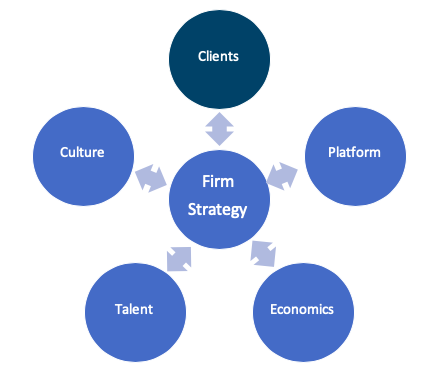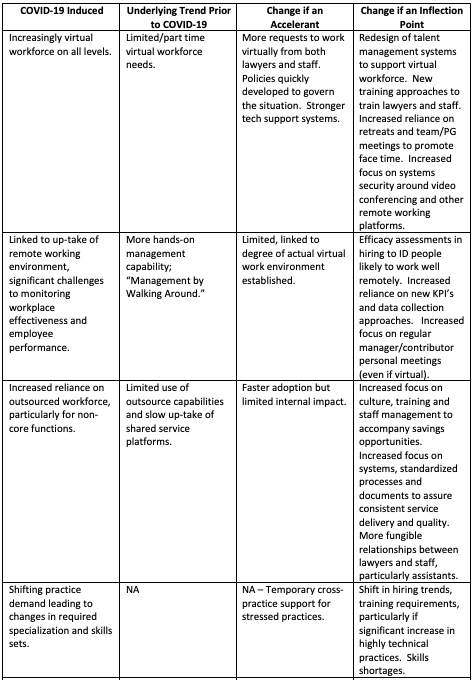By Joe Altonji, Mike Short, Mark Medice and Yvonne Nath
In our COVID-19 Recovery Playbook, we provided our thinking for firm leadership on how to manage through the current crisis. In this four-part continuation of that work, we examine where and how the industry may be shaped by the current health crisis facing the world. In Part 1, we present some thoughts on the types of trends and changes that the crisis has the potential to create in society, and by extension, the legal profession. In Part 2, we look at how client demands might change in light of this pandemic. In Part 3, we look at how these trends might affect the commercial law firm platform. Finally, in Part 4 we discuss how any firm might better prepare itself to weather future “Black Swan” events while coming out the back end in a healthier and better economic position.
In the second installment of this series, we introduced a number of potential trends that might emerge broadly from the client base of commercial law firms. We want to now shift our attention to trends that might emerge directly in and around the law firm itself as a result of Covid-19 – either directly on the law firm or indirectly via clients. We grouped these trends into four broad impacted areas – economics, platform, talent and culture, as shown in the following figure:

We begin with economics because in many ways economics are critical. If the firm can’t handle the economic changes, it is unlikely to get to the rest of the challenges. In the short term (which corresponds to the early stages of our Recovery Playbook), economic conditions tend to drive most decision-making. Longer term, we look at trends around economic factors and how they might change, and the implications of those changes for law firm management and operations.

Platform and Operations Considerations: For simplicity we capture a wide range of changes under “Platform and Operations,” including technology, space, support structures and others.

Talent Considerations: Law firms have sometimes been described as a collection of talent that voluntarily reassembles every day. To the extent material trend changes impact the law firm, the nature of the talent needed, and how that talent base comes together and unites to deliver client services will change. Here we include some potential shifts around the law firm talent base.


Cultural Considerations: Here we include a wide range of topics around how people work and behave. The triggering trends are cultural in nature, while the changes might be described as talent oriented, or even operational.

Overall Changes in Legal Business Model
If we pull all of this together, what differences might we expect to see in the legal industry a few years out? Obviously, the answer depends more on how the pandemic ultimately changes society than it does on targeted changes to the legal world specifically. If we make the assumption that the societal level changes are profound, then the corresponding impacts on law will be equally profound.
If we think about a world where COVID-19 has significant and permanent effects on our social, political, cultural and economic norms, we can envision a legal industry that adapts to incorporate and account for those changes (as it always does). However, that does not mean that every firm will change in precisely the same ways – in fact, we would anticipate the opposite, with increasing diversification of the legal business models used, with some approaches having more lasting impact than others. Some of the general changes we would anticipate happening include:
- A significant and fairly rapid change in the direction of creating more flexible, resilient and lower-cost platforms with materially reduced fixed cost commitments (especially real estate) and increased capabilities around remote working, dispersed and potentially partially outsourced workforces managed with new metrics, new talent management techniques, and new approaches to maintain cultural connectivity.
- A significant new focus on talent scale, depth and redundancy, with a heightened interest and receptivity to combinations generally, but particularly among firms focused on multi-national/jurisdictional client bases. If these clients rally behind the idea, there will also be a commensurate increase in pressures for multi-disciplinary service delivery models that lead to material in-roads in US legal world by the Big-4. The overall goal here is an aligned trusted advisor/true business partner model wherever the client may have needs.
- For smaller and mid-size firms, an increased focus on a limited range of services where the firm can be deep and offer significant differentiation. Undifferentiated “generalist” firms lacking the ability to truly partner with clients will risk gradual erosion of profitability and market relevance.
- More commoditized services will be increasingly dominated by large, process-driven organizations (including accounting firms and ALSP’s) or sophisticated (in the handling of such services) law firms.
- Increased interest and promotion by firms of AFA’s, and continual moves toward subscription-based practices in appropriate areas or types of client relationships.
- As an extension of remote working becoming increasingly normal, a significant re-think of talent acquisition, training, management, and retention strategies. This would include 1) an increased geographic dispersion of workforces as leading firms in specific practice areas look to other geographies for additional talent depth in the absence of needing to open offices, and/or 2) a movement toward sourcing administrative personnel in lower cost locations (including legal assistants, potentially). The net result is an increased focus on scalable work force.
- A significant advancement in the area of data management and analytic capability across all firm functions, with a particularly strong emphasis on profitability and performance metrics, particularly those focused on client management, performance, and connection to firm and lawyers.
- An intense focus on culture management with the goal of assuring resilience, flexibility and connectivity.
Ten years from now, law firms will still look a lot like they do today, at least to outside lay observers looking at their websites and public sources of information. To the trained eye, however, their supporting functionality will have changed dramatically, their competitive worlds will have evolved rapidly, and their leadership ranks will have turned over almost entirely from the “baby boomer” generation still largely in place today. How clients and their law firms work together will likely be different in material ways. Some of this will happen no matter what, but if our overall society is reconfigured by the current pandemic, the changes in law will be equally profound.
In our final installment of this series, we will focus on how law firms can rethink their strategic, management and leadership approaches to better position themselves to respond differently to future crises and emerge from them in a better strategic position than the starting point.



